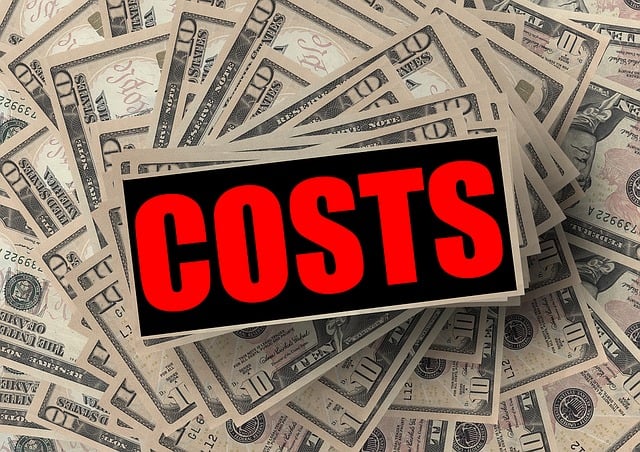Futu Trading Cost: Complete Fee Breakdown
Author: Jameson Richman Expert
Published On: 2025-11-04
Prepared by Jameson Richman and our team of experts with over a decade of experience in cryptocurrency and digital asset analysis. Learn more about us.
Futu trading cost can make a meaningful difference to your net returns whether you're trading stocks, ETFs, or fractional shares. This article explains what comprises Futu’s trading costs, how to calculate them, how they compare with competitors, and practical steps to lower expenses. You’ll also find examples, comparison checklists, and links to high-quality resources and related trading guides to help you make smarter, cost-aware trading decisions.

Why understanding futu trading cost matters
Fees reduce your returns. Even modest differences in commission, spreads, or foreign exchange (FX) conversion costs compound over time and erode gains — especially for active traders or those using margin. Knowing the components of futu trading cost helps you estimate true break-even points, design effective trade sizing and risk management, and select the right account type or platform for your goals.
Who is Futu? A brief overview
Futu Holdings Limited operates an online brokerage and wealth management platform popular in Asia and beyond. It provides access to markets such as Hong Kong, US, and some other international exchanges via its trading app. While features and fee structures vary by region and account type, the typical cost categories are similar across brokers.
For an overview of trading strategies that can affect fee outcomes, see this guide on Bitcoin trading strategy for beginners.
Core components of futu trading cost
Break down your total cost into these discrete items. Each contributes to the overall futu trading cost you’ll pay per trade or over time.
- Commission — A per-trade fee charged by the broker. Can be fixed or percentage-based.
- Exchange and clearing fees — Fees charged by the exchange and clearinghouse; often passed through to you.
- Spread — The difference between bid and ask. When using market orders, you implicitly pay the spread.
- FX conversion charges — For cross-currency trades (e.g., buying US stocks with HKD), brokers apply conversion spreads or fees.
- Regulatory and stamp taxes — Country-specific levies such as stamp duty in Hong Kong or transaction levies elsewhere.
- Margin interest — Cost of borrowing when using margin or leverage.
- Data, platform, and inactivity fees — Premium market data or subscription fees and penalties for inactivity in some account tiers.
- Deposit and withdrawal fees — Charges or bank fees when moving money in/out.
- Overnight financing and swap fees — For derivatives and leveraged positions.
Why spread matters as much as commission
Many traders focus on commissions but overlook the spread. A tight commission-free trade with a wide spread can cost more than a small commission with a tight spread. Futu trading cost must therefore account for explicit commissions and implicit costs like spread and market impact.

How to calculate your futu trading cost (step-by-step)
Use this simple method to calculate the total cost of a single trade and project annualized costs for your strategy.
- List explicit fees: commission + exchange fees + regulatory taxes on the trade.
- Estimate spread cost: (Ask - Bid) / Mid-price. Multiply this percentage by trade value to estimate implicit spread cost when executing at market price.
- Include FX fees: If currency conversion is required, add the conversion fee or spread percentage applied by Futu.
- Add margin interest: For leveraged trades, compute interest incurred for holding the position during the period.
- Calculate per-trade total: Sum items above; divide by trade value to get a percentage cost.
- Project annual cost: Multiply per-trade cost by the average number of trades and add recurring fees (data, subscriptions).
Example: You place a $10,000 US stock trade with a $5 commission, a 0.01% exchange fee ($1), and estimated spread cost of 0.02% ($2). FX conversion is 0.25% ($25). Total cost = $5 + $1 + $2 + $25 = $33 -> 0.33% of trade value. That 0.33% is the true single-trade futu trading cost.
Common fee scenarios at Futu — what you might encounter
Fee schedules differ by jurisdiction and account tier. Below are typical scenarios that influence the final futu trading cost:
- Retail individual investor, low frequency: Small fixed commissions or tier-based percentage commissions, occasional FX costs for cross-border trades, no margin interest if not using leverage.
- Active trader or day trader: Higher number of trades increases cumulative commission and spread costs; margin interest may apply for leveraged intraday positions; you might qualify for lower per-trade commission if your volume is high.
- Investors using margin: Pay margin interest rates (annualized), which add to holding costs for leveraged strategies.
- Institutional or premium accounts: Negotiated fees, potentially lower commission or better FX rates, but possibly higher platform fees for advanced features.
Comparing futu trading cost to other brokers and platforms
Comparison helps put Futu’s fees into perspective. When comparing, use a per-trade percentage and annualized cost calculation rather than raw fee numbers. Here are elements to compare:
- Commission structure (fixed vs tiered vs percentage)
- FX conversion rates and how they’re quoted (spread vs flat fee)
- Availability and cost of market data and research tools
- Margin rates and financing terms
- Regulatory fees and how they are passed on
For cryptocurrency traders, compare costs and features across crypto-native platforms as well. If you also trade crypto, these reputable exchanges and referral links may be useful to open accounts and compare fee structures:
- Open a Binance account — wide product range, competitive maker/taker fees
- MEXC registration — supports many altcoins and promotions
- Bitget referral — derivatives and copy trading features
- Bybit invite — advanced derivatives, competitive fees for futures
While these are crypto-specific platforms, they illustrate how fee models differ across the trading universe. For equities and ETF trading, benchmark Futu’s costs against large brokers and local incumbents.

Hidden costs and less obvious contributors to futu trading cost
Beyond explicit fees, watch out for these elements that can increase your effective cost:
- Market impact: Large orders can move the market and increase execution cost. Consider limit orders or breaking orders into smaller slices.
- Slippage: The difference between expected price and executed price, especially in volatile or low-liquidity instruments.
- Routing and smart order features: Some brokers route orders through specific venues for rebates or price improvement; others do not, which influences fill quality.
- Currency layering: Multiple conversions (e.g., local currency -> USD -> HKD) amplify FX fees.
- Opportunity cost: Cash sitting idle versus deployed; margin funding decisions.
Actionable ways to reduce your futu trading cost
Practical steps to lower fees and improve net returns:
- Choose the right account tier — If you trade often, higher tier accounts or volume-based discounts reduce per-trade commission.
- Use limit orders when appropriate — Avoid market orders in illiquid assets to reduce spread and slippage costs.
- Consolidate trades — Combine smaller trades into larger ones to reduce per-trade fixed fees, when this doesn’t harm execution price.
- Monitor FX exposure — Keep cash balances in the trading currency or use FX hedging to avoid repeated conversion fees.
- Leverage fee-free alternatives — For long-term buy-and-hold investors, low-fee brokers or commission-free plans might be optimal.
- Negotiate fees — High-net-worth or high-volume traders can often negotiate better rates; ask your account manager for custom pricing.
- Use internalized cash management — Move funds infrequently and use bank channels with predictable fees to avoid unexpected withdrawal costs.
Real-world example: calculating futu trading cost for an international investor
Scenario: You live in Singapore and want to buy US stocks through Futu. You plan to execute 50 trades per year, each averaging $8,000.
- Estimated commission per trade: $4 (hypothetical)
- Exchange & clearing fees: $0.80 per trade
- Average spread cost per trade: 0.015% of trade value -> $1.20
- FX conversion: 0.2% -> $16 per trade (if converting SGD to USD each trade)
Total per-trade cost: $4 + $0.80 + $1.20 + $16 = $22 -> 0.275% per trade.
Annual trading cost = 50 trades * $22 = $1,100. If you reduce FX conversions by batching deposits and holding USD on the platform, you can save $16 per trade and reduce annual costs by $800.
This example illustrates the outsized role FX fees can play and why currency management is critical to lowering overall futu trading cost.

Futu trading cost and tax considerations
Taxes are not a broker fee but must be included in your cost calculation. Short-term gains may be taxed at higher rates in many jurisdictions. Keep thorough records of commissions and fees as they are often deductible against capital gains in many countries. Consult authoritative tax guidance such as the IRS’s pages on capital gains (for US taxpayers) or your local tax authority for specific rules.
US IRS resource: IRS Topic No. 409 — Capital Gains and Losses
Quality of execution: why paying a little more can be worth it
Lowest fees are attractive, but execution quality matters. A broker with slightly higher commission but better fills, faster execution, and superior routing can save you money in the long run. Review fill quality metrics and trade confirmations, and consider factors like platform reliability and customer service.
To learn more about execution tactics and bots that can aid consistent trade execution, see this step-by-step guide on trading bots: How Bybit trading bot works. Although focused on crypto, many principles of automation and cost control apply across markets.
How to monitor and audit your futu trading cost
Regular audits help you identify hidden leaks and improve efficiency. Follow this checklist:
- Export monthly trade confirmations and fee summaries from your Futu account.
- Calculate average cost per trade and per asset class.
- Compare actual FX rates used vs mid-market rates at the time of conversion.
- Assess the proportion of costs coming from spreads, slippage, or commissions.
- Track recurring subscription fees (data, platform) and weigh them against the benefits.

When futu trading cost shouldn’t be the only decision factor
Do not pick a broker solely on the lowest fee. Consider:
- Security and regulation — ensure your broker is regulated in your jurisdiction.
- Customer service and dispute resolution.
- Platform features: research tools, order types, API access, mobile experience.
- Market coverage and speed of execution for the instruments you trade.
High-quality educational resources and market analysis can improve trade outcomes and outweigh small fee differences. For active crypto traders, regular market updates like the Bitcoin price USD latest news and market analysis and short-term outlooks such as this 1-week short term outlook and trading plan can help you avoid costly timing and execution errors.
Checklist: Compare futu trading cost before opening an account
- Download the broker’s fee schedule and identify per-trade commission, exchange fees, and FX rates.
- Ask whether fees are negotiable at your expected monthly volume.
- Confirm margin interest rates and how interest is calculated.
- Check whether market data or advanced platform features incur extra charges.
- Ask about withdrawal and deposit fees for your preferred funding methods.
- Request sample trade confirmations to verify typical execution prices and spreads.
Additional resources and learning links
To build a fee-aware trading approach, consult reputable educational sources:
- Broker (Wikipedia) — background on brokerage roles and services.
- Investopedia — Understanding Broker Commissions
- Beginner trading strategies — to align strategy with cost structure.

Frequently asked questions about futu trading cost
Q: Are Futu’s commissions negotiable?
A: Many brokers offer tiered pricing or negotiated rates for high-volume traders. Contact Futu’s account team to discuss volume-based discounts or premium account tiers.
Q: How much does FX conversion typically add to cost?
A: FX costs vary widely. Even low spreads of 0.1–0.3% can exceed explicit commission on small trades. Batching conversions and keeping balances in the trading currency reduces repeated FX charges.
Q: Do stamp duties or regulatory fees apply?
A: Yes — jurisdictions like Hong Kong levy stamp duty on equities. These are passed through by brokers. Include them in your total cost calculations.
Q: How do I evaluate execution quality?
A: Compare execution prices to time-stamped mid-market prices, check fill rates for limit orders, and examine any partial fills or slippage. Ask for trade reports or use analytics platforms to benchmark execution.
Conclusion — managing futu trading cost for better outcomes
Understanding futu trading cost means accounting for both explicit and implicit fees: commissions, exchange and regulatory levies, spread and slippage, FX conversion, margin interest, and recurring platform costs. Use the calculation method above, perform regular audits, and implement practical cost-reducing steps such as batching FX conversions, using limit orders, and negotiating fee tiers for active trading. Remember that the cheapest option is not always the most profitable — execution quality, platform reliability, and service matter.
If you trade cryptocurrencies as well, integrate crypto fee comparisons and strategy guides into your workflow. Explore market analysis and tools such as the market updates linked above for practical trading insights, and consider setting up accounts on reputable exchanges using the referral links provided earlier to compare fees and features in real time.
Take action: download your Futu fee schedule, run the sample per-trade calculation with your average trade size, and test two alternative brokers or exchanges over a month to compare real-world costs and execution. Being fee-aware is one of the simplest ways to improve your investment performance over time.